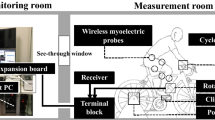Abstract
Bilaterality and motor lateralization have been associated with neural lateralization, suggesting that the dominant and non-dominant systems might have different specializations. The study of symmetrical motor tasks can provide evidence relating to this hypothesis. The water polo eggbeater kick is a skill comprising anti-phase and directionally opposite rotations of the right and left lower limbs to provide upward thrust to elevate the body. Effectiveness of the skill depends on moving the feet in predominantly horizontal directions with an orientation that produces lift throughout as much of the cycle as possible. The purpose of this study was to investigate the motor lateralization of the dominant (D) and non-dominant (ND) lower limbs during the execution of the water polo eggbeater kick technique. Twelve right-handed and right-footed water polo players performed eggbeater kicks in the vertical position to maintain maximum height. Three-dimensional kinematics and the pattern of vertical forces were quantified for nine cycles for each player. The pattern of vertical force produced showed asymmetries between the equivalent phases of the cycles of the dominant and non-dominant limbs (D, 222.8 N; ND, 201.0 N; p < 0.001). Based on the vertical force patterns, the non-dominant ankle had a less efficient motion during the phase of knee flexion (recovery phase). This was a consequence of larger negative pitch angles created by the non-dominant foot for the equivalent phase. Negative pitch angles counteract the lift forces responsible for the upward propulsion of the player. The effectiveness of the dominant side during the recovery phase was a consequence of bilateral differences in rotation and inversion motions by the ankle and hip. Differences in the technique of the dominant and non-dominant side, particularly during the phase of knee flexion, supported the ‘dynamic dominance theory’ where each hemisphere/limb might be tuned to control different parameters of task performance.








Similar content being viewed by others
References
Annett J, Annett M, Hudson PT, Turner A (1979) The control of movement in the preferred and non-preferred hands. Q J Exp Psychol 31:641–652
Auerback BM, Ruff CB (2006) Limb bone bilateral asymmetry: variability and commonality among modern humans. J Hum Evol 50:203–218
Bagesteiro LB, Sainburg RL (2002) Handedness: dominant arm advantages in control of limb dynamics. J Neurophysiol 88:2408–2421
Bagesteiro LB, Sainburg RL (2003) Nondominant arm advantages in load compensation during rapid elbow joint movements. J Neurophysiol 90(3):1503–1513
Bagesteiro LB, Sainburg RL (2005) Interlimb transfer of load compensation during rapid elbow joint movements. Exp Brain Res 161(2):155–165
Brinkman J, Kuypers HG, Lawrence DG (1970) Ipsilateral and contralateral eye-hand control in split-brain rhesus monkeys. Brain Res 24(3):559
Carnahan H, Elliott D (1987) Pedal asymmetry in the reproduction of spatial locations. Cortex 23:157–159
Carpes FP, Rossato M, Faria IE, Bolli Mota C (2007) Bilateral pedaling asymmetry during a simulated 40-km cycling time-trial. J Sports Med Phys Fitness 47:51–57
Carson RG, Chua R, Elliott D, Goodman D (1990) The contribution of vision to asymmetries in manual aiming. Neuropsychologia 28(11):1215–1220
Chua R, Carson RG, Goodman D (1992) Asymmetries in the spatial localization of transformed targets. Brain Cogn 20(2):227–235
Chung LH, Remelius JG, Van Emmerik RE, Kent-Braun JA (2008) Leg power asymmetry and postural control in women with multiple sclerosis. Med Sci Sports Exerc 40:1717–1724
Colebatch JG, Rothwell JC, Day BL, Thompson PD, Marsden CD (1990) Cortical outflow to proximal arm muscles in man. Brain 113:1843–1856
Czabanski B (1975) Asymmetry of lower limbs in breastroke swimming. In: Lewillie L, Clarys JP (eds) Swimming II. University Park Press, Baltimore
Czabanski B, Koszcyc T (1979) Relationship of stroke asymmetry and speed of breastroke swimming. In: Terauds J, Bedingfield EW (eds) Swimming III. University Park Press, Baltimore
Deffeyes J, Sanders RH (2005) Elliptical zone body segment modelling software: digitising, modelling and body segment parameter calculation. In: Wang Q (ed.), XXIII International symposium on biomechanics in sports, Beijing: The China Institute of Sports Science
Downwar JM, Sauers EL (2005) Clinical measures of shoulder mobility in the professional baseball player. J Athl Train 40:23–29
Ducher G, Jaffre C, Arlettaz A, Benhamou C, Courteix D (2005) Effects of long term tennis playing on the muscle-bone relationship in the dominant and non-dominant forearms. Can J Appl Physiol 30:3–17
Elliott D, Roy EA, Goodman D, Carson RG (1993) Asymmetries in the preparation and control of manual aiming movements. Can J Exp Psychol 47(3):570–589
Elliott D, Lyons J, Chua R, Goodman D, Carson RG (1995) The influence of target perturbation on manual aiming asymmetries in right-handers. Cortex 31(4):685–697
Formosa DP, Sayersa MGL, Burketta B (2014) Stroke-coordination and symmetry of elite backstroke swimmers using a comparison between net drag force and timing protocols. J Sports Sci 32:220–228
Harrington DL, Haaland KY (1991) Hemispheric specialization for motor sequencing: abnormalities in levels of programming. Neuropsychologia 29(2):147–163
Hasan Z (1986) Optimized movement trajectories and joint stiffness in unperturbed, inertially loaded movements. Biol Cybern 53(6):373–382
Herzog W, Nigg BM, Read LJ, Olsson E (1989) Asymmetries in ground reaction force patterns in normal human gait. Med Sci Sports Exerc 21:110–114
Hirasawa Y (1979) An observation on standing ability of Japanese males and females. J Anthr Soc Nippon 87:81–92
Hirasawa Y (1981) Left leg supporting human straight (bipedal) standing. Saiensu 6:32–44
Holstege JC, Kuypers HG (1982) Brain stem projections to spinal motoneuronal cell groups in rat studied by means of electron microscopy autoradiography. Prog Brain Res 57:177–183
Homma M, Homma M (2005) Coaching points for the technique of the eggbeater kick in synchronized swimming based on three-dimensional motion analysis. Sports Biomech 4:73–87
Hunt MA, Sanderson DJ, Moffet H, Inglis TJ (2004) Interlimb asymmetry in persons with and without an ACL deficiency during stationary cycling. Arch Phys Med Rehabil 85:1475–1478
Jensen RK (1976) Model for body segment parameters. In: Komi PV (ed) Biomechanics VB. University Park Press, Baltimore
Karamanidis K, Arampatzis A, Bruggemann GP (2003) Symmetry and reproducibility of kinematic parameters during various running techniques. Med Sci Sports Exerc 35:1009–1016
Kimura D, Archibald Y (1974) Motor functions of the left hemisphere. Brain 97:337–350
Kobayashi Y, Kubo J, Matsuo A, Matsubayashi T, Kobayashi K, Ishii N (2010) Bilateral asymmetry in joint torque during squat exercise performed by long jumpers. J Strength Cond Res 24:2826–2830
Kolb B, Milner B (1981) Performance of complex arm and facial movements after focal brain lesions. Neuropsychologia 19:505–514
Kuypers HG (1982) A new look at the organization of the motor system. Prog Brain Res 57:381–403
Leroy D, Polin D, Tourny-Chollet C, Weber J (2000) Spatial and temporal gait variable differences between basketball, swimming and soccer players. Int J Sports Med 21:158–162
Liu D, Todorov E (2007) Evidence for the flexible sensorimotor strategies predicted by optimal feedback control. J Neurosci 27(35):9354–9368
Mieschke PE, Elliott D, Helsen WF, Carson RG, Coull JA (2001) Manual asymmetries in the preparation and control of goal-directed movements. Brain Cogn 45(1):129–140
Moll J, de Oliveira-Souza R, Passman LJ, Cunha FC, Souza-Lima F, Andreiuolo PA (2000) Functional MRI correlates of real and imagined tool-use pantomimes. Neurology 54:1331–1336
Nirkko AC, Ozdoba C, Redmond SM, Burki M, Schroth G, Hess CW, Wiesendanger M (2001) Different ipsilateral representations for distal and proximal movements in the sensorimotor cortex: activation and deactivation patterns. NeuroImage 13:825–835
Palmer E, Ashby P (1992) Corticospinal projections to upper limb motoneurones in humans. J Physiol 48:397–412
Palmer AR, Strobeck C (1986) Fluctuating asymmetry: measurement, analysis, patterns. Annu Rev Ecol Syst 17:391–421
Parson AR (1990) Fluctuating asymmetry: an epigenetic measure of stress. Biol Rev 65:131–145
Peters M (1988) Footedness: asymmetries in foot preference and skill and neuro-psychological assessment of foot movement. Psychol Bull 103(2):179–192
Psycharakis SG, Sanders RH (2009) Validity of the use of a fixed point for intracycle velocity calculations in swimming. J Sci Med Sport 12:262–265
Sadeghi H, Allard P, Duhaime M (1997) Functional gait asymmetry in able-bodied subjects. Hum Mov Sci 16:243–258
Sadeghi H, Allard P, Prince F, Labelle H (2000) Symmetry and limb dominance in able-bodied gait: a review. Gait Posture 12:34–45
Sadeghi H, Sadeghi S, Allard P, Labelle H, Duhaime M (2001) Lower limb muscle power relationships in bilateral able-bodied gait. Am J Phys Med Rehabil 80(11):821–830
Sainburg RL (2002) Evidence for a dynamic-dominance hypothesis of handedness. Exp Brain Res 142(2):241–258
Sainburg RL (2005) Handedness: differential specializations for control of trajectory and position. Exerc Sport Sci Rev 33(4):206–213
Sainburg RL, Kalakanis D (2000) Differences in control of limb dynamics during dominant and nondominant arm reaching. J Neurophysiol 83:2661–2675
Sanders RH (1999a) Analysis of the eggbeater kick used to maintain height in water polo. J Appl Biomech 15:284–291
Sanders RH (1999b) A model of kinematic variables determining height achieved in water polo boosts. J Appl Biomech 15:270–283
Sanders RH (2013) How do asymmetries affect swimming performance?. J Swim Res 21:1–17
Sanders RH, Alcock A, Donald N, Riach I, Wright L, Fairweather M (2012a) The swimming asymmetry puzzle: putting the pieces together. Sports science conference. Denizli, Turkey
Sanders RH, Alcock A, Fairweather M (2012b) Is correction of asymmetries important in swimming?. FINA world medicine conference. Istanbul, Turkey
Sanders RH, Thow J, Alcock A, Fairweather M, Riach I, Mather F (2012c) How can asymmetries in swimming be measured?. J Swim Sci 19:1–15
Schiltz M, Lehance C, Maquet D, Bury T, Crielaard JM, Croisier JL (2009) Explosive strength imbalances in professional basketball players. J Athl Train 44:39–47
Scott SH (2002) Optimal strategies for movement: success with variability. Nat Neurosci 5(11):1110–1111
Scott SH (2004) Optimal feedback control and the neural basis of volitional motor control. Nat Rev Neurosci 5(7):532–546
Seifert L, Chollet D, Allard P (2005) Arm coordination symmetry and breathing effect in front crawl. Hum Mov Sci 24:234–256
Seifert L, Chehensse A, Tourny-Chollet C, Lemaitre F, Chollet D (2008) Effect of breathing pattern on arm coordination symmetry in front crawl. J Strength Cond Res 22:1670–1676
Smak W, Neptune RR, Hull ML (1999) The influence of pedaling rate on bilateral asymmetry in cycling. J Biomech 32:899–906
Steenhuis RE, Bryden MP (1989) Different dimensions of hand preference that relate to skilled and unskilled activities. Cortex 25:289–304
Swaine IL (1997) Time course of changes in bilateral arm power of swimmers during recovery from injury using a swim bench. Br J Sports Med 31:213–216
Todor JI, Kyprie PM (1980) Hand differences in the rate and variability of rapid tapping. J Mot Behav 12(1):57–62
Todor JI, Smiley-Oyen AL (1987) Force modulation as a source of hand differences in rapid finger tapping. Acta Psychol 65(2):65–73
Todorov E, Li WW, Pan XC (2005) From task parameters to motor synergies: a hierarchical framework for approximately optimal control of redundant manipulators. J Robot Syst 22(11):691–710
Triggs WJ, Calvanio R, Levine M, Heaton RK, Heilman KM (2000) Predicting hand preference with performance on motor tasks. Cortex 36:679–689
Vanden-Abeele J (1980) Comments on the functional asymmetry of the lower extremities. Cortex 16(2):325–329
Wang J, Sainburg RL (2007) The dominant and nondominant arms are specialized for stabilizing different features of task performance. Exp Brain Res 178(4):565–570
Zifchock RA, Davis I, Hamill J (2006) Kinetic asymmetry in female runners with and without retrospective tibial stress fractures. J Biomech 39:2792–2797
Conflict of interest
The authors declare that they have no conflict of interest.
Compliance with ethical standards
All procedures performed in studies involving human participants were in accordance with the ethical standards of the institutional and/or national research committee and with the 1964 Helsinki Declaration and its later amendments or comparable ethical standards. Informed consent was obtained from all individual participants included in the study.
Author information
Authors and Affiliations
Corresponding author
Rights and permissions
About this article
Cite this article
Oliveira, N., Sanders, R.H. Kinematic and kinetic evidence for functional lateralization in a symmetrical motor task: the water polo eggbeater kick. Exp Brain Res 233, 947–957 (2015). https://doi.org/10.1007/s00221-014-4166-8
Received:
Accepted:
Published:
Issue Date:
DOI: https://doi.org/10.1007/s00221-014-4166-8




